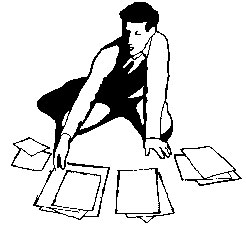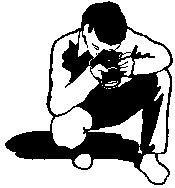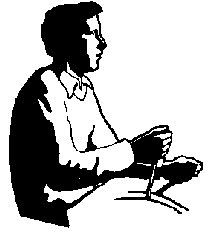
The
Frank Olson Legacy
Project
Points
on the Collage Path:
Scan & grasp
< Get a box — Scan & grasp — Make piles >

“Certain objects, like psychic ‘keys,’ open doors to unconsciously intense—and rich—experience in which we articulate the self that we are through the elaborating character of our response.”
— Christopher Bollas
“On Being a Character: Psychoanalysis and Self Experience,” 1992
The path continues with scanning, reaching-out, and grasping—perceptually based actions that correspond to the orality of infancy and to the expression of desire in adulthood. These actions open deep reservoirs of psychic hunger, initiating the complex passage from physiological need, to articulated demand, to unconscious desire.

Scan
& grasp
The Collage Path: Polylogue
3
Scan & grasp
“Certain
objects, like psychic ‘keys,’ open doors to unconsciously intense—and
rich—experience in which we articulate the self that we are through
the elaborating character of our response.”
— Christopher Bollas
On Being a Character: Psychoanalysis and Self Experience, 1992
“At the museum entrance, a man asked me if I’d like to check
my bag. I said no. I never checked my bag. I needed my things too much.”
—Mona Simpson
The Lost Father, 1992
“Opening up and reaching out are an expansive movement of the organism
toward a source of energy or pleasure. The same action is involved whether
a child reaches out for contact with the mother, for a toy or later as
an adult, for a loved person. ”
— Alexander Lowen
Bioenergetics, 1975
“[…in acts of recognition, motivation and feeling] value may
be adumbrated before the perception of forms is complete.”
—Susanne Langer
Mind: An Essay on Human Feeling, Vol. 1, 1967
“The poet’s mind is in fact a receptacle for seizing and storing
up numberless feelings, phrases, images, which remain there until all
the particles can unite to form a new compound are present together.”
— T.S. Eliot
“Tradition and the Individual Talent,” 1919 / 1975
“Only images can set the verbs in motion again.”
— Gaston Bachelard
The Poetics of Space, 1958
“The soul cannot think without an image.”
— Aristotle
Poetics
“Iconic mental states have, in other words, psychic force.”
— Richard Wollheim
The Thread of Life, 1984
“…the infant’s scanning search with his senses and above
all, his eyes, and his renewed recognition of what is continuously lost
and found again, is the first significant interplay (later to be re-tested
in such games as, say, peekaboo).”
— Erik H. Erikson
Toys and Reasons: Stages in the Ritualization of Experience, 1977
“The idea of an immense photographic archive was at first rejected
because it posed such huge difficulties of classification: how could discrete
elements be isolated in the continuum of images…?”
— C. Ginzburg
“Clues: Morelli, Freud, Sherlock Holmes,” 1973, in Umberto Eco
and Thomas Seboek, eds, The Sign of Three
“Both the immune system and the nervous system can be seen as systems
for recognition. The immune system has to recognize all foreign intruders,
to categorize them, reliably, as ‘self’ or ‘not self.’
The task of the nervous system is roughly analogous, but far more demanding:
it has to classify, to categorize, the whole sensory experience of life,
to build from the first categorizations, by degrees, an adequate model
of the world; and in the absence of any specific programming or instruction
to discover or create its own way of doing this.”
— Oliver Sacks
“Making up the Mind,” review of Gerald M. Edelman, Bright
Air, Brilliant Fire, in The New York Review of Books, April
8, 1993
“[…in acts of recognition, motivation and feeling] value may
be adumbrated before the perception of forms is complete.”
— Susanne Langer
Mind: An Essay on Human Feeling, Vol. 1, 1967
“The delight of photographs consists in their ability to grant us
a socially sanctioned engagement with our instinctual selves, unaccompanied
by actual risk… An observer of photographs (the term includes us
all) is not some kind of voyeur manqué, but has become, just the
same, a person made sensitive to an expectation of certain visual opportunities
that no previous art form could furnish. Some of these opportunities are
indeed masturbatory and rape-like, but the majority of them kindle more
diffused needs that link people together, through their reflexes as well
as their obsessions.”
— Max Kozloff
Photography and Fascination, 1979
“After my father died, I discovered a trunk that had once belonged
to his mother in the cellar of his house. It was locked, and I decided
to force it open with a hammer and screwdriver, thinking it might contain
some buried secret, some long lost treasure. As the hasp fell down and
I raised the lid, there it was, all over again — that smell, wafting
up towards me, immediate, palpable, as if it had been my grandmother herself.
I felt as though I had just opened her coffin.”
— Paul Auster
The Invention of Solitude, 1982
“As though she were a child always on the verge of rebuilding the
universe through found objects — or found images — no language
but the most rudimentarily joyful could describe the moment when she happened
upon signposts leading to her self-expression.”
— Hilton Als
“Unmasked” [On the Diane Arbus collection Untitled ]
The New Yorker, November 27, 1995, pp. 92-93.
“Certain objects, like psychic ‘keys,’ open doors to unconsciously
intense — and rich — experience in which we articulate the self
that we are through the elaborating character of our response. This selection
constitutes the jouissance of the true self, a bliss released through
the finding of specific objects that free idiom to its articulation. As
I see it, such releasings are the erotics of being: these object both
serve the instinctual need for representation and provide the subject
with the pleasures of the object’s actuality.…
Those objects and experiences, keys to the releasing of our idiom, free
us to experience the depth of our being and of the interplay between the
movement of our idiom, driven by the force of our instincts, and the unconscious
system of care provided by our mother and father. We are forever finding
objects that disperse the objectifying self into elaborating subjectivities,
where the many ‘parts of the self’ momentarily express discrete
sexual urges, ideas, momories, and feelings in unconscious actions, before
condensing into a transcendental dialectic, occasioned by a force of dissemination
that moves us to places beyond thinking.…
A day is a space for the potential articulation of my idiom. Do I select
objects that disseminate my idiom or not? For example, do I pick up a
novel which I don’t like but think I should read — but through
which I shall not come into my being — or do I select a novel which
I like, into which I can fall, losing myself to multiple experiences of
self and other? Do I have a sense of this difference of choice? What if
I don’t? What if I do not intuitively know which object serves me?
If I don’t know then my day is likely to be a fraught or empty occasion.
Neuroitic conflict eradicates, at least for a time, potential objects.…
Or I may choose an object because it is meant to resolve a state of anxiety
or to recontact a split-off part of myself housed there. In other words,
pathology of mind biases the subject toward the sleection of objects that
are congruent with unconscious illness.…
The ego chooses not only what aspect of an object to use but also what
subjective mode to employ in the use.…
We can learn much about about any person’s self experienceing by
obseriving his selection of objects, not only because object choice is
lexical and therefore features in the speech of character syntax, but
also because it may suggest a variation in the intensity of psychic experience
that each person chooses. If we live an active life, then we will create
a subjectified material world of psychic significance that both contains
evocative units of prior work and offers us new objects that bring our
idiom into being by playing us into our reality.”
— Christopher Bollas
“On Being a Character: Psychoanalysis and Self Experience,”
1992 (pp.17, 24, 43, 32)
“Clinical work knows little about how creative sublimation works,
because it is mainly concerned with interpreting and translating the contents
of unconscious phantasy… My point will be that unconscious scanning
makes use of undifferentiated modes of vision that to normal awareness
would be chaotic… [The] primary process is a precision instrument
for creative scanning that is far superior to discursive reason and logic.”
— Anton Ehrenzweig
The Hidden Order of Art, 1967
“Anticipatory looking (manipulative prehension) begins to be learned
at birth… With time, there is more feed forward and priming so that
the hand is shaped to grasping as the reach is going forward.… Moreover,
the sequence always ends at the mouth — never, be it noted, before
the eyes for closer inspection or for bimanual manipulation.”
— Jerome Bruner
“Eye, Hand and Mind,” 1969
“As the radius of physical reach and of cognitive comprehension,
of libidinal attachment and of responsible action — as all these
expand, there will, of course, always be persons who are substitutes for
the original mother.… I would conclude that the early mother’s
equivalent in each later stage must always be the sum of all the persons
and institutions which are significant for his wholeness in an expanding
arena of interplay.”
— Erik H. Erikson
“Play and Actuality,” 1972
“The Ucs. [system unconscious] is also affected by experiences originating
from external perception. Normally all the paths from perception to the
Usc. remain open, and only those leading on from the Usc. are subject
to blocking by repression.…
It is as though the unconscious stretches out feelers, through the medium
of the Pcpt-Cs. [perceptual conscious system], towards the external world
and hastily withdraws them as soon as they have sampled the excitations
coming from them.”
— Sigmund Freud
“The Unconscious,” 1915 / 55;
“A Note Upon the ‘Mystic Writing Pad’,” 1915 / 55
“The physical prototype of this good safe way of incorporating exists
in the ‘good’ sucking activity at the breast, which takes without
injuring (in fact produces more milk) and uses the good milk inside for
growth and to become a good child to the mother. In sucking too the good
substance taken in becomes hidden and irrecoverable, yet is known and
felt to be indubitably there; growth and well-being testify to its presence.”
(55)
— Joan Riviere
“On the Genesis of Psychical Conflict in Earliest Infancy,”
1936 (In M. Klein, Developments in Psychoanalysis)
“…where perception of objects is concerned, the world, [Gerald]
Edelman likes to say, is not ‘labeled,’ it does not come ‘already
parsed into objects.’ We must make them, in effect, through our own
categorizations: ‘Perception makes,’ Emerson said, ‘Every
perception,’ says Edelman, echoing Emerson, ‘is an act of creation.’”
— Oliver Sacks
“Making up the Mind,” review of Gerald M. Edelman, Bright
Air, Brilliant Fire, in The New York Review of Books, April
8, 1993
“…rhythmic ocillation [between recognition of static visual
patterns and thinking in sounds or movements] … may have a specific
[brain] function … of transforming a spatial pattern of things seen
[associated with reduced alpha activity] into a succession of signals
in time [associated with high alpha activity]… The transformation
from spatial to temporal coordinates is known…as scanning.”
— W. Grey Walter
“Activity Patterns in the Human Brain,” 1958
“[The] image with its whole cargo of feeling…is the modulus
of imagination. ‘In the complexity of our mental organization it
is sort of living cell, which maintains its life through manifold and
diverse transformations’.… Literally speaking imagination is
the activity which embodies in mentally perceptible forms the effects
of our sensory impressions, present and past. Fashioned by this action
… the image is neither memory nor invention; it is sheer reprsentation…”
The high intellectual value of images … lies in the fact that they
usually, and perhaps always, fit more than one actual experience…
Consequently, we tend to se the form of one thing in another, which is
the most essential factor in making the maelstrom of events and things
pressing upon our sense organs a single world. In this way all the things
which one image roughly fits are gathered together as instances of one
conception… The original image may have been derived in roundabout
and irrecoverable ways. But it fits many impressions, even if somewhat
imperfectly, nearly enough to permit their treatment as things of one
kind.…
Ordilnarily, in the kind of thinking which civilized adults today call
‘common sense,’ every familiar physical object has a stable
dominant gestalt according to which it is publicly classified, i.e., named;
and how it is named determines the way we experience it even privately.…”
— Susanne Langer
quoting Jean Philippe,
Mind: An Essay on Human Feeling,
Vol. 1, 1967; Vol. 2,1972
“In a state ofradical ego-centrism there is complete lack of differentiation
between the ego and the external world, and consequently a state of non-consciousness
of the ego, or projection of enternal impressions into the forms provided
by the external world, which is the same thing. The origin of the unconscious
symbol is to be found in the suppression of consciousness of the ego by
complete absorption in, and identification with, the external world, and
it therefore constitutes merely a limited case of assimilation of reality
to the ego, i.e., of ludic symbolism.”
— Jean Piaget
Play, Dreams and Imitation in Childhood, 1962
“Suppose we were to regard a dream as a kind of game which the dreamer
played. (And by the way, there is no one cause or one reason why children
always play. This is where theories of play generally go wrong.) There
might be a game in which paper figures were put together to form a story,
or at any rate were somehow assembled. The materials might be collected
and stored in a scrap-book, full of pictures and anecdotes. The child
might then take various bits from the scrap-book to put into the construction;
and he might take a considerable picture because it had something in it
which he wanted and he might just include the rest because it was there.”
— Ludwig Wittgenstein
Lectures and Conversations on Aesthetics, Psychology and Religious Belief,
1943/1978
“Not games. Puzzles. Big difference. That’s a whole other matter.
All art — symphonies, architecture, novels — it’s all puzzles.
The fitting together of notes, the fitting together of words have by their
very nature a puzzle aspect. It’s the creation of form out of chaos.
And I believe in form.”
— Stephen Sondheim
In Stephen Schiff, “Deconstructing Sondheim,” The New Yorker,
March 8, 1993, p. 76.
“God creates, I assemble.”
— George Balenchine
In Arlene Croce, “The Spelling of Agon,”
The New Yorker, July 12, 1993, p. 91
“[…in acts of recognition, motivation and feeling] value may
be adumbrated before the perception of forms is complete.”
— Susanne Langer
Mind: An Essay on Human Feeling, Vol.
1, 1967
“Anticipatory looking (manipulative prehension) begins to be learned
at birth… With time, there is more feed forward and priming so that
the hand is shaped to grasping as the reach is going forward.… Moreover,
the sequence always ends at the mouth — never, be it noted, before
the eyes for closer inspection or for bimanual manipulation.”
— Jerome Bruner
“Eye, Hand and Mind,” 1969
“The Ucs. [system unconscious] is also affected by experiences originating
from external perception. Normally all the paths from perception to the
Usc. remain open, and only those leading on from the Usc. are subject
to blocking by repression.…
It is as though the unconscious stretches out feelers, through the medium
of the Pcpt-Cs. [perceptual conscious system], towards the external world
and hastily withdraws them as soon as they have sampled the excitations
coming from them.
— Sigmund Freud
“The Unconscious,” 1915 / 55;
“A Note Upon the ‘Mystic Writing Pad’,” 1915 / 55
“The physical prototype of this good safe way of incorporating exists
in the ‘good’ sucking activity at the breast, which takes without
injuring (in fact produces more milk) and uses the good milk inside for
growth and to become a good child to the mother. In sucking too the good
substance taken in becomes hidden and irrecoverable, yet is known and
felt to be indubitably there; growth and well-being testify to its presence.”
(55)
— Joan Riviere
“On the Genesis of Psychical Conflict in Earliest Infancy,”
1936
(In M. Klein, Developments in Psychoanalysis )
“Clinical work knows little about how creative sublimation works,
because it is mainly concerned with interpreting and translating the contents
of unconscious phantasy… My point will be that unconscious scanning
makes use of undifferentiated modes of vision that to normal awareness
would be chaotic… [The] primary process is a precision instrument
for creative scanning that is far superior to discursive reason and logic.”
— Amton Ehrenzweig
The Hidden Order of Art, 1967
“…rhythmic ocillation [between recognition of static visual
patterns and thinking in sounds or movements] … may have a specific
[brain] function … of transforming a spatial pattern of things seen
[associated with reduced alpha activity] into a succession of signals
in time [associated with high alpha activity]… The transformation
from spatial to temporal coordinates is known…as scanning.”
— W. Grey Walter
“Activity Patterns in the Human Brain,” 1958
“Only images can set verbs in motion again.”
— Gaston Bachelard
The Poetics of Space, 1958
“Iconic mental states have, in other words, psychic force.”
— Richard Wollheim
The Thread of Life, 1984
“[The] image with its whole cargo of feeling…is the modulus
of imagination. ‘In the complexity of our mental organization it
is sort of living cell, which maintains its life through manifold and
diverse transformations’.… Literally speaking imagination is
the activity which embodies in mentally perceptible forms the effects
of our sensory impressions, present and past. Fashioned by this action
… the image is neither memory nor invention; it is sheer reprsentation…”
The high intellectual value of images … lies in the fact that they
usually, and perhaps always, fit more than one actual experience…
Consequently, we tend to se the form of one thing in another, which is
the most essential factor in making the maelstrom of events and things
pressing upon our sense organs a single world. In this way all the things
which one image roughly fits are gathered together as instances of one
conception… The original image may have been derived in roundabout
and irrecoverable ways. But it fits many impressions, even if somewhat
imperfectly, nearly enough to permit their treatment as things of one
kind.…
Ordilnarily, in the kind of thinking which civilized adults today call
‘common sense,’ every familiar physical object has a stable
dominant gestalt according to which it is publicly classified, i.e., named;
and how it is named determines the way we experience it even
privately.…”
— Susanne Langer
quoting Jean Philippe,
Mind: An Essay on Human Feeling,
Vol. 1, 1967; Vol. 2,1972
“Suppose we were to regard a dream as a kind of game which the dreamer
played. (And by the way, there is no one cause or one reason why children
always play. This is where theories of play generally go wrong.) There
might be a game in which paper figures were put together to form a story,
or at any rate were somehow assembled. The materials might be collected
and stored in a scrap-book, full of pictures and anecdotes. The child
might then take various bits from the scrap-book to put into the construction;
and he might take a considerable picture because it had something in it
which he wanted and he might just include the rest because it was there.”
— Ludwig Wittgenstein
Lectures and Conversations on Aesthetics, Psychology and Religious Belief,
1943/1978
Points
on the collage path

Scan
& grasp
Copy & cut
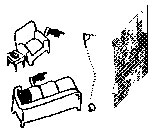
Scan & speak
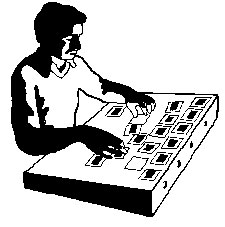
Make image strings
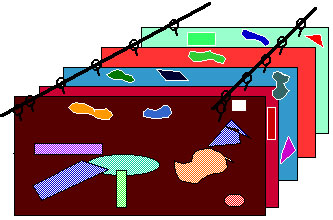
Put the
collage in the archive
Return the signs to the universe
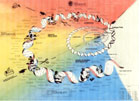

.png)
.jpg)
